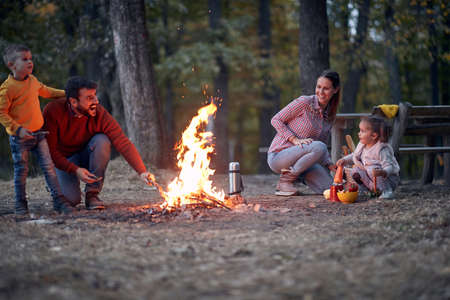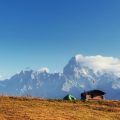Choosing the Right Campsite
When planning a camping trip with babies and toddlers, selecting the right campsite is key to ensuring a fun and stress-free adventure. Look for family-friendly campgrounds that offer safe, well-maintained sites with plenty of space for little ones to play. Many American campgrounds provide amenities such as clean restrooms, hot showers, changing tables, and even playgrounds—these conveniences can make your stay much easier when traveling with young children. Consider choosing a site close to facilities so you don’t have to walk far with your baby or toddler. Some campgrounds also offer stroller-friendly trails or paved paths, perfect for exploring together. Check if the campsite allows campfires and grills, but be sure it’s easy to keep children at a safe distance from any hazards. Finally, read reviews from other families to get an idea of how welcoming and accommodating the campground is for parents with young kids. Making these thoughtful choices will help set the stage for a memorable and enjoyable camping experience for your whole family.
Packing Essentials for Little Ones
When camping with babies and toddlers, smart packing is key to ensuring a smooth and enjoyable outdoor experience. Young children have unique needs, so having the right supplies on hand will keep everyone comfortable, safe, and happy. Here’s a practical checklist of must-have gear and supplies designed specifically for families with little adventurers.
Must-Have Camping Gear for Babies and Toddlers
| Category | Essentials |
|---|---|
| Sleeping Comfort | Portable crib or pack n play, toddler sleeping bag or wearable blanket, favorite comfort item (stuffed animal/blanket), white noise machine or app |
| Feeding Supplies | Bibs, spill-proof cups/bottles, formula/breastfeeding gear, snacks and easy meals, travel high chair or booster seat, wipes and extra burp cloths |
| Clothing & Protection | Weather-appropriate layers, sun hats, rain gear, extra socks/shoes, swimwear, baby-safe sunscreen and bug spray |
| Hygiene & Health | Diapers/pull-ups, changing pad, diaper rash cream, hand sanitizer, travel potty (if potty training), first aid kit with kids meds |
| On-the-Go Gear | Baby carrier or hiking backpack, compact stroller (good for trails), playpen for safe outdoor play, lightweight picnic blanket/mat |
| Entertainment & Comfort | Favorite toys/books, bubbles or nature-friendly activities, nightlight or headlamp for kids, sound machine for sleep routines |
Pro Tips for Packing Smart:
- Pack at least one full extra outfit per child per day—outdoor messes are part of the fun!
- Bring plenty of snacks and easy-to-eat meals that don’t require much prep.
- If your child uses a pacifier or lovey to sleep, pack extras in case one gets lost in the great outdoors.
- Keep all essentials organized in clear bins or labeled bags so you can easily grab what you need—especially helpful during midnight wake-ups.
- A small spray bottle with water is handy for quick clean-ups at your campsite.
- If camping in bear country, store all food and scented items safely away from your sleeping area.
Packing thoughtfully ensures you’re ready for any adventure—and helps little campers feel secure away from home. With this checklist in hand, you’ll be able to focus on making memories together under the stars!
![]()
3. Sleeping Arrangements and Routines
Ensuring a good night’s sleep for your little ones is essential when camping with babies and toddlers. Creating a cozy, familiar sleep environment can help your child feel safe and comfortable even in the great outdoors. Here are some practical tips to make bedtime easier for everyone:
Choose the Right Sleeping Gear
Invest in a high-quality family tent that provides enough space for everyone, including a designated sleeping area for your baby or toddler. Bring along a portable crib, travel bassinet, or toddler air mattress depending on your child’s age and preferences. Lay down foam mats or thick blankets under sleeping bags to add extra cushioning and insulation from the ground.
Keep It Familiar
Try to recreate your child’s home sleep environment as much as possible. Pack their favorite blanket, stuffed animal, or sleep sack to provide comfort and a sense of security. If your baby is used to white noise at home, consider bringing a battery-operated sound machine or playing gentle nature sounds on your phone.
Stick to Your Routine
Consistency is key when it comes to bedtime routines, even while camping. Follow your usual steps—whether it’s reading a story, singing lullabies, or having a bottle—before tucking your child in. Keeping these rituals will signal that it’s time to wind down, helping your little one adjust more easily to sleeping in a new place.
Be Mindful of Temperature
Nights outdoors can get chilly, so dress your child in layers of breathable pajamas and use sleep sacks rated for outdoor temperatures. Always check on them through the night to make sure they’re not too hot or cold.
With thoughtful planning and a few comforts from home, you can help ensure everyone gets the rest they need for another day of fun in the fresh air!
4. Safety Tips for Babies and Toddlers
Ensuring your little ones are safe during a camping trip is every parent’s top priority. With the excitement of being outdoors, it’s easy to overlook some potential hazards that can turn an adventure into a stressful situation. Here are some essential tips for childproofing your campsite and protecting your kids from common outdoor risks.
Childproofing Your Campsite
Before you let your baby or toddler explore, take a few moments to scan your campsite for possible dangers. Remove sharp sticks, rocks, and any trash left by previous campers. If you’re using a campfire, set up a clear boundary—like a ring of stones or camping chairs—to keep curious hands away. Keep all matches, lighters, knives, and tools well out of reach. It’s also helpful to designate a safe play area using a portable playpen or blanket where your child can crawl or toddle around safely.
Common Outdoor Risks and How to Prevent Them
| Risk | Prevention Tips |
|---|---|
| Sun Exposure | Use baby-safe sunscreen, dress in lightweight long sleeves, and provide hats and shade. |
| Insects & Ticks | Apply baby-friendly insect repellent, use netting on strollers/cribs, and check for ticks after hikes. |
| Water Hazards | Always supervise near lakes or streams; use life jackets for toddlers near water. |
| Plants & Poison Ivy | Learn to identify toxic plants; teach older toddlers not to touch unknown plants. |
| Campsite Hazards | Keep hot drinks/foods out of reach; secure tent stakes/guy lines; sweep for choking hazards. |
Emergency Preparedness
No matter how careful you are, accidents can happen. Always pack a well-stocked first aid kit with supplies tailored for babies and toddlers—think extra band-aids, antiseptic wipes, infant pain reliever, and any prescription medications. Know the nearest hospital or urgent care location, and make sure your phone is charged in case you need to call for help. It’s also smart to carry a list of emergency contacts and allergy information just in case.
By taking these simple precautions, you can focus on making wonderful outdoor memories with your family—knowing your little ones are safe and sound as they discover the joys of nature!
5. Fun Activities for the Whole Family
One of the greatest joys of camping with babies and toddlers is sharing simple, joyful activities that everyone can enjoy together. The key is to choose fun, low-pressure experiences that spark curiosity and encourage exploration, no matter your child’s age or stage. Here are some easy and engaging ideas to help your family make the most of your outdoor adventure:
Nature Walks & Scavenger Hunts
Even young children love to wander and explore. Take slow-paced nature walks around your campsite or on nearby trails. Turn it into a scavenger hunt by creating a list of simple items—like pinecones, acorns, or specific colored leaves—for little ones to find. For babies in carriers, narrate what you see and touch safe objects together.
Sensory Play with Nature
Bring along a blanket and let your baby or toddler sit and play with natural materials like sticks, rocks, leaves, and pine needles (always supervise closely!). Fill small buckets with water for splashing or mud for squishing—simple pleasures that offer hours of entertainment and support sensory development.
Campground Games
Classic games can be easily adapted for the outdoors. Try a gentle game of tag, “Duck Duck Goose,” or ring toss using soft rings made from rope. For older toddlers, set up an obstacle course using logs, rocks, or camp chairs—they’ll love the challenge!
Storytime Under the Trees
Pack a few favorite board books or picture books to read together in a cozy spot under the shade. Making storytime part of your camping routine brings comfort and familiarity while also connecting your child with the sounds and sights of nature.
Star Gazing & Nighttime Exploration
If your little ones are still awake after sunset, bundle up in pajamas and share a quiet moment looking at the stars. Toddlers will be fascinated by flashlights or glow sticks—try hunting for fireflies or listening for night-time animal sounds together.
Tips for Success
Keep activities flexible and follow your child’s lead—sometimes just digging in the dirt or stacking rocks is all they need! Remember to pack extra clothes for messy play, plenty of snacks, and take lots of breaks to rest and recharge.
6. Weather Preparedness and Comfort
When camping with babies and toddlers, staying comfortable through changing weather is key to a happy experience for the whole family. Young children are especially sensitive to temperature shifts, so dressing them appropriately and being prepared for anything Mother Nature brings will help keep everyone safe and cozy.
Layering Is Your Best Friend
The secret to managing unpredictable outdoor weather is layering clothes. Pack lightweight base layers that wick moisture, such as cotton or merino wool bodysuits, followed by warmer mid-layers like fleece pullovers or sweatshirts. Top it off with a waterproof jacket or windbreaker when needed. Dressing your child in several thin layers allows you to easily add or remove clothing as temperatures change throughout the day.
Don’t Forget Accessories
Hats, mittens, and socks are small but essential. Babies lose heat quickly through their heads and feet, so bring extra beanies and thick socks for chilly mornings and nights. Sun hats with wide brims protect little faces from harsh rays during sunny afternoons.
Be Ready for Rain or Shine
Packing a rain suit or poncho for your toddler can make wet weather less daunting. Waterproof boots are also handy for puddle jumping and muddy trails. For sunny days, don’t forget sunscreen (baby-friendly formulas), sunglasses, and lightweight long sleeves for added sun protection.
Keep Sleeping Arrangements Cozy
At night, temperatures can drop quickly. Use insulated sleeping bags designed for kids or layer blankets over your baby’s sleep sack. Make sure your tent is well-ventilated to prevent condensation but zipped up tight against bugs and chilly winds.
Check the Forecast—But Prepare for Surprises
Always review the local weather forecast before heading out, but pack an emergency kit with extra clothes, blankets, and weatherproof gear just in case conditions change unexpectedly. Being prepared will give you peace of mind so you can focus on making joyful memories with your little adventurers!
7. Making Mealtime Easy at the Campsite
Mealtime in the great outdoors doesn’t have to be stressful, even when you’re camping with babies and toddlers. With a bit of planning and some handy tricks, you can keep little tummies happy while making your own life easier. Here are some practical tips to help you prepare, store, and serve meals that work for the whole family.
Simple Meal Planning
When it comes to meal planning for young kids, keep it simple and familiar. Stick to foods your child already enjoys at home, such as oatmeal, fruit, pasta, or sandwiches. Plan easy-to-assemble meals like wraps, quesadillas, or pre-cooked chicken strips. Prepping ingredients at home—like chopping veggies or cooking rice—can save you valuable time at the campsite.
Prep Ahead for Less Stress
Before you head out, portion out snacks and meals into reusable containers or zip-top bags. Pre-make things like pancakes or muffins and freeze them; they’ll thaw in your cooler and be ready to eat on-site. Don’t forget baby-friendly finger foods like cut-up fruit, string cheese, or mini crackers for quick snacking.
Smart Storage Solutions
Keeping food fresh is key! Bring a well-insulated cooler with plenty of ice packs or frozen water bottles to keep perishables cold. Store dry goods and snacks in airtight containers to protect them from critters and moisture. Remember to pack bibs, wipes, and extra utensils for easy cleanup after each meal.
Feeding Baby at the Campsite
If your baby is still bottle-feeding or nursing, bring what you need for comfort and safety. Consider bringing bottled water for mixing formula, a portable high chair or booster seat for mealtimes, and a lightweight bib that’s easy to clean. For toddlers who love independence, bring spill-proof cups and toddler-sized utensils so they can feed themselves without too much mess.
Keep It Fun and Flexible
Campsite meals don’t have to be perfect—what matters most is making sure everyone gets enough nourishment to enjoy their outdoor adventure! Keep expectations realistic, embrace the occasional mess, and remember that eating together under the open sky is part of the camping magic. With these simple strategies, you can make mealtime one of the highlights of your family’s camping trip.


